Air pollution of Delhi is rising day by day and Delhi pollution is now became a serious issue for the public health. Sometime there are also improvement which is shown by the awareness campaigns. But it still pushes the concentration of PM2.5 and other pollutants who are hardiest range. This problem is arriving from the mixing of local sources such as traffic, road dust, construction industry, municipal solid waste fires, cooking fuels and regional transport such as crop warning and metrology. The citizens’ actions also play a major role in my mitigations.
In this blog, I will give you detailed information about what is air pollution, how it is measured, and why air pollution in Delhi is in trend and in high level.
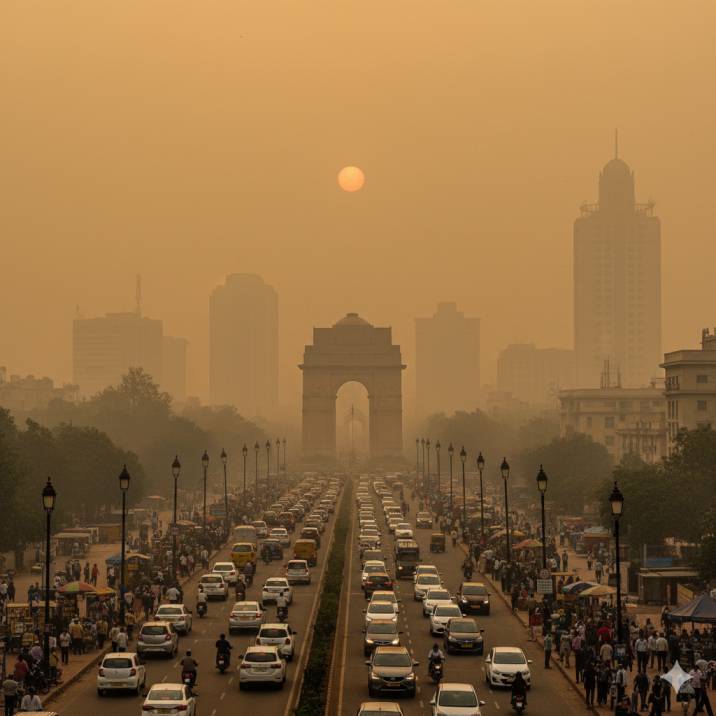
What we mean by “air pollution” & how it’s measured
Now let us talk about what is air pollution and how it is measured. Air pollution is something might call like what is the amount of presence of harmful substance in the atmosphere, such as gases like NO2,SO2, O3, CO, and particular matter PM10 and PM2.5. PM2.5 is considered as dangerous because it goes deep into the lungs and bloodstream. Generally, air quality is represented by AQI which is Air Quality Index which translates the pollutant concentration in air into the category like good, moderate, poor, very poor, or Severe.
PM2.5 is considered very dangerous because it is consider very harmful in long-term risks like heart disease, stroke, chronic lung disease, lung cancer, and which is the cause of premature death.
Current Air Pollution Trend In Delhi
Delhi comes under the cities in which pollution is high over the world. From the past decades, some efforts have been made, such as the Awareness Campaign, Vehicle Emissions Standards, Clear Fuels, ODE, E1 Trials, Dust Management, etc., but AQI spikes remain extreme during the winter and festival seasons.
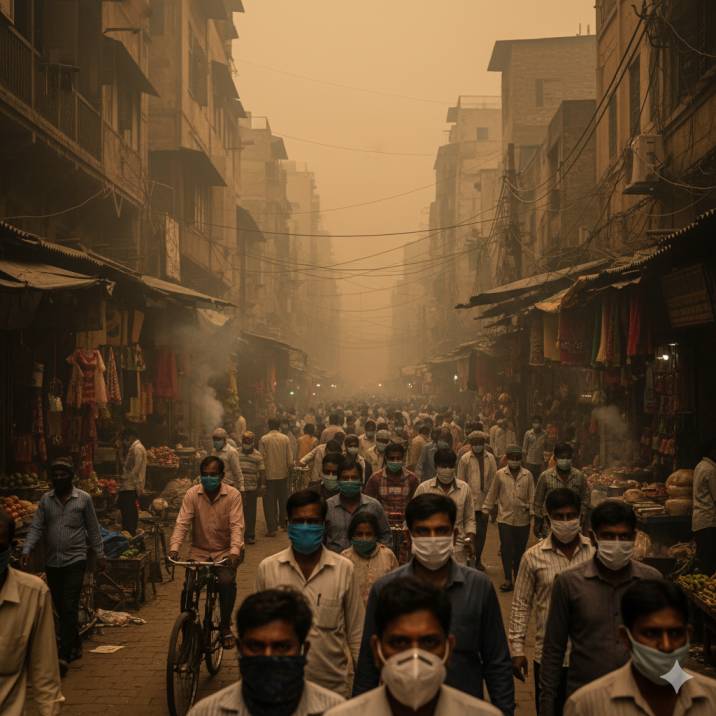
Major air pollution reasons / causes behind Delhi’s smog (breaking them down)
In air pollution of Delhi, large numbers of vehicle are responsible for the major air pollution. Vehicles such as cars, trucks, two-wheelers emits M8s, NOx, PMs, VOCs, and older diesel vehicles as well as heavy trucks contribute very much in producing pollution, but Delhi has now applied the rule that after every 10 year, any vehicle is not allowed in Delhi to drive. Slow-moving vehicles increase the emissions per kilometer, and Delhi is traffic-congested. That’s why the people in Delhi move slowly in their vehicles and produce large pollution.
Road Dust and Resuspension: A large share of particulate pollution is suspended road dust, such as from upward surfaces, poor sweeping, braking, tyre wear, and construction debris. Surveys and sources have appointed studies and attribute a big chunk of PM10 and PM2.5 c.
Regional Agriculture Burning: In Punjab and Haryana, seasonal crops are burned after harvest, and this burning causes a cloud of smoke and attains a certain wind pattern. This cloud moves towards Delhi and creates amplified smoke. Research and reporting consistently highlighted this issue as a major contributor in air pollution during winter in Delhi.
Industrial Emissions and Power Plants are also responsible for air pollution of Delhi: These are the point sources of air pollution in Delhi because industries and NCR as well as thermal power plants add SO2, NOx, and particles. Some industries follow the government guidelines to regulate legacy sources and non-compliant but some companies have not followed the rules.
Domestic Household Fuel Burning: Open Waste Fire, and Landfill Fires While most of Delhi’s households use LPG for the use but Pockets still uses solid-fire which is additionally opposed to the burning of municipal waste and episodes.
Construction as Demolition Dust: Because of the intense urban development, such as construction of building flats and houses, construction sites and transport of materials produce harmful dust.
Seasonal pattern: when and why Delhi gets worst
Delhi’s worst pollution is seen form before post-monsoon to winter because as we talk in above section that in Punjab and Haryana, thousands of acres crops have been burned every year after the harvest so agriculture burning peak after paddy harvest and this period is between October to November. Cool and cooler temperature and calm winds create stable environment atmospheric layer which prevent vertical dispersion. From sometimes increased uses of heating and sometimes biomass combustion plays a significant part in pollution. Sometimes festivals are also responsible for Delhi’s pollution.
At other time, the high temperature and wind improve the desperation, but storms and local dust source make summer and warm season more pollutant days.
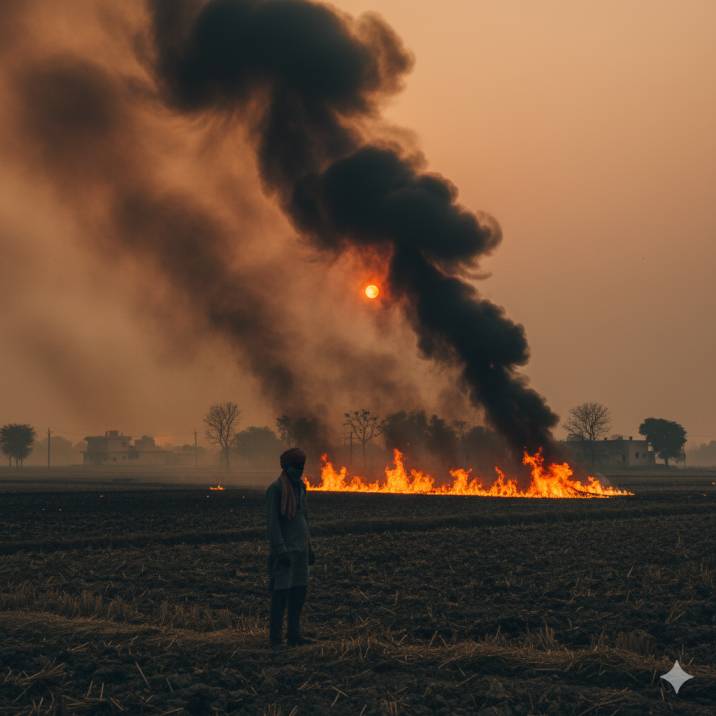
Health impacts — what “air pollution effects” does Delhi cause?
Now let us talk about what are the health effects due to the pollution in Delhi. So there are both long-term and short-term effects which evaluated PM 2.5, which is the reason behind respiratory illness like asthma, bronchitis, reduced lung function in children, second cardiovascular disease, there is high risk of ischemic heart disease, stroke, and heart failure, third increased infant mortality and adverse pregnancy outcome like low birth weight, etc. Fourth neurological effects like emerging in evidence of long-term PM 2.5 exposure to cognitive decline and increased Alzheimer’s-type pathology.
In recent news, there is highlight between chronic pollution and dementia progression. Fifth Overall Attribute Burden WHO, World Health Organization, and Global Assessment have shown that people living in Delhi have a very high rate of premature death due to ambient air pollution.
There are also health care effects such as there is a rise in health care costs because of the rapid case of health-related disease, schools remain closed sometimes because of severe AQI disease, people who are tourists and people who want to go outdoor suffer a lot, sometimes ecosystem effects seen by reducing in visibility due to the massive pollution and damage to crops by ozone and particulate deposition and stress on urban trees.

Air pollution in Bangalore (Bengaluru)
Now let us talk about how air pollution looks like in Bangalore, does it have same condition as in Delhi or different? So Bangalore history has better air quality than Delhi but in recent time it is showing deterioration with growth in vehicle fleet and road dust. In Delhi winter spikes are heavily influenced because of regional mass burning and winter meteorology but Bangalore is facing air pollution majorly because of vehicle emission, road dust, construction dust and local urban growth patterns.
In seasonally Bangalore’s peaks don’t align with crop burning seasons like Delhi has. But Bangalore face year-round challenges from traffic and rapid increase in vehicle number. In recent studies or surveys in 2024 or 2025, it is shown that Bangalore is losing its clean air due to the rising vehicle emission and road dust but its PM 2.5 peak are usually lower than Delhi’s. As a result, Bangalore’s air is not more harmful such as of Delhi.
What governments and agencies are doing (policy & tech responses)
Now let us talk about what are the efforts made by the governments and the agencies for controlling the air pollution of Delhi, First, “Great Response Action Plan”, This was the emergency plan for Delhi that make restriction on the engines or on the things which crosses AQI limits. This plan is implemented by CPCB and CAQM depending on the AQI and metrology forecast.
National Clean Air Programme NCAP. This programme is launched in 2019 with a specific target to reduce PM by 20-30% across Identify but not attempt cities through multi-sector inventions. Funding the action plan rolled out city by city. Clear fuels, vehicle norms, scrappage and EV push. India has adopted Bharat Stage VI (BS-VI) fuels and vehicle standards. This policy promotes electric vehicles, public transport upgrades and vehicle scrappage which are the part of the strategy.
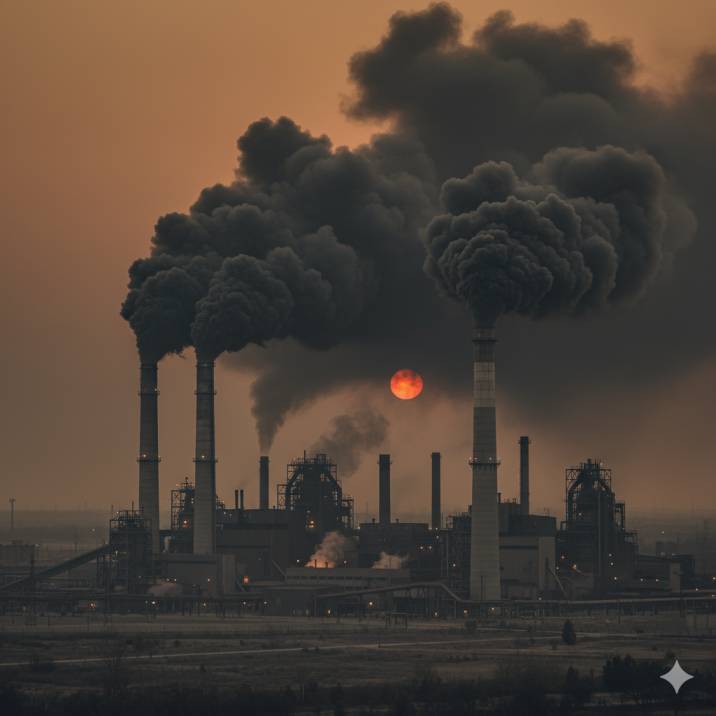
What more can be done — high-impact approaches
Scale up agricultural residue alternatives: subsidized machinery (happy seeders, straw management), economic incentives to stop burning. This reduces the seasonal regional load.
Aggressive dust control & road cleaning: mechanized sweeping, paved shoulders, water suppression during dry months.
Tight enforcement of industrial emissions and construction rules; retrofit older plants.
Last-mile public transport and traffic management: reduce private-vehicle reliance by improving bus/metro last-mile connectivity and non-motorized transport options.
Faster adoption of clean energy & distributed renewables to reduce DG set dependency.
(Behavioral / citizen)
Reducing outdoor exposures on high AQI days, using appropriate masks (N95/FFP2), indoor air purifiers for sensitive groups, avoiding burning waste at home.
Source: International recommendations (WHO), NCAP priorities, and expert commentary.
Impact of Air Pollution on Children in Delhi
Now let us talk about the most important part of this blog that what are the impact of air pollution on the children’s which are living in Delhi. As we all know that children’s are the group which are most vulnerable when it comes to air pollution of Delhi. Their lungs and immune system are in the stage of developing not fully developed to prevent disease and they breathe in more the air in their body as compared to adults. This means that harmful particles like PM2.5, PM10 and toxic gases has stronger effect on children’s as compared to the adults. Now let us talk about what are the problems faced by the children’s.
First, respiratory health problem: This is the most common effect which is seen in children. Kids in Delhi often complain for presence of throat irritation and sweating, higher rate of asthma problem and bone cheats compared to the children in clear air regions, reducing in the lung capacity which may not fully recover even when they grow older.
Second, impact on brain development and learning: Recent studies have shown that the long-term exposure to these particles matters with reducing in their cognitive function and memory in children. This shows that air pollution of Delhi not only affects the student’s physical health but also interferes in their academic performance with brain development.
Third, during the worst smoke days in winter, Delhi’s schools are forced to be shut down for some days by the government. Even when the school is closed, students are forced to not go outdoors which are missing physical activities, outdoor sports and sunlight exposure. This creates indirect but significant effects on their growth and well-being.
Fourth, psychological and emotional development: I know most of the people think that how does air pollution cause psychological and emotional effects but constant health issues, restricted playtime and awareness of smoke can increase stress and anxiety among young children and teenagers. Imagine an example that you are living in an area where all the time you see the news of how people die at an early age due to pollution, how your city’s pollution is rising day by day, how you are more vulnerable to it, that creates a long-term stress effect.
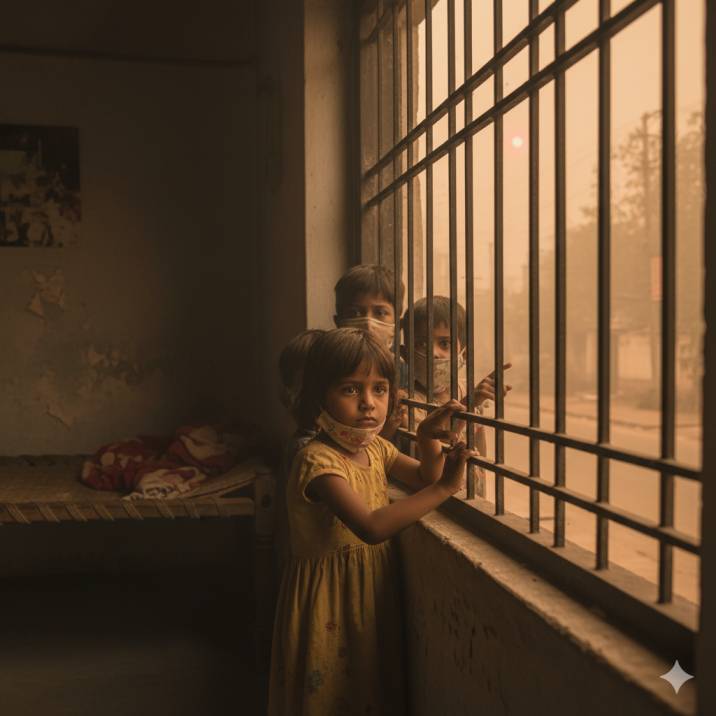
Technology Solutions for Air Pollution
In today’s days, air pollution of Delhi has become one of the biggest problems in India. But to fight against this problem our government has developed some policies and technologies, air pollution of Delhi is not only about making policies and regulations. The use of proper technology plays very crucial role. Now let us talk about what are the technology solutions which is made by the government for air pollution.
1. Air Quality Monitoring System: Delhi has invented a network of real-time air quality monitors, which is managed by CPCB and IIT projects like SAFAR. These devices are capable to provide hourly updates on PM2.5, PM2.10 and toxic gases. And the data of these monitors are provided by the apps and websites, which allow citizens to check pollution levels, plan outdoor activities and avoid peak exposure hours.
2. Smoke Towers and Large-Scale Air Purifier Delhi has installed smoke towers at Kanganaut place and Anand Vihar to test the weather to test whether large air filtration units can reduce particulate levels in a localized area. These towers are highly efficient to particulate air (HEPA) filtration and ionization technology.
3. Electric Vehicle and Cleaner Transport: As we all know that vehicle emission is one of the biggest sources of air pollution in Delhi. But Delhi has a plan for shifting towards electric buses, e-Rickshaws and EV cars, which reduce dependence on fossil fuels. Delhi’s EV policy 2020 aims to make 25% of all new vehicle registration electric by 2024, which could significantly cut annuals and particulates emissions.
Table of Contents
Sources of Information
- World Health Organization (WHO) – Ambient (outdoor) air pollution and health (Fact sheet, 2023)
https://www.who.int/news-room/fact-sheets/detail/ambient-(outdoor)-air-quality-and-health - WHO Report – Air Pollution and Child Health: Prescribing Clean Air (2018)
https://www.who.int/publications/i/item/air-pollution-and-child-health - Central Pollution Control Board (CPCB), India – Air Quality Status Reports & National Air Quality Index
https://cpcb.nic.in/ - Commission for Air Quality Management (CAQM) – Graded Response Action Plan (GRAP) Guidelines
https://caqm.nic.in/ - National Clean Air Programme (NCAP), MoEFCC, Government of India – City Action Plans & Progress Reports
https://ncap.niua.org/ - SAFAR (System of Air Quality and Weather Forecasting And Research), IITM/IMD – Real-time air quality data and source apportionment
http://safar.tropmet.res.in/ - Centre for Science and Environment (CSE), New Delhi – Studies on road dust, waste burning, construction pollution
https://www.cseindia.org/ - IQAir Air Quality Rankings (2024–2025) – Global and Indian city comparisons (Delhi vs Bangalore)
https://www.iqair.com/in-en/ - The Guardian (2023) – Reports on stubble burning in Punjab & Haryana and Delhi smog episodes
https://www.theguardian.com/environment - Times of India / Indian Express Reports (2024–2025) – Air pollution in Bangalore and Delhi, seasonal trends, and policy updates
https://timesofindia.indiatimes.com/
https://indianexpress.com/ - Nature & Lancet Studies – Long-term health impacts of PM2.5, neurological effects, and premature mortality estimates
https://www.nature.com/
https://www.thelancet.com/
